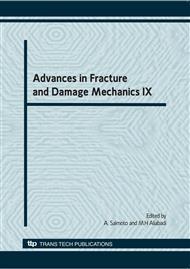p.157
p.161
p.165
p.169
p.173
p.177
p.181
p.185
p.189
Computational Analysis of the AFM Specimen on Mixed-Mode II and III Fracture
Abstract:
Some results of 3D finite element analyses of the all fracture modes (AFM) specimen on mixed-mode II and III fracture are presented in this paper. The computational fracture analysis is based on the calculation of separated strain energy release rates (SERRs) along the crack front by the modified virtual crack closure integral (MVCCI)-method and the commercially available FE-code ANSYS. Calculation results show that under pure in-plane shear loading (mode II), not only the mode II, but also the mode III loading conditions, are generated owing to the Poission’s ratio effects. Similarly, under pure out-of-plane shear loading (mode III), besides the mode III, the mode II loading conditions are induced due to the global deformation. Nevertheless, once in-plane and out-of-plane shear loadings are superimposed, the fracture behavior appears more complex. Further discussion is given associate with some previous study.
Info:
Periodical:
Pages:
173-176
Citation:
Online since:
November 2010
Authors:
Price:
Сopyright:
© 2011 Trans Tech Publications Ltd. All Rights Reserved
Share:
Citation:


